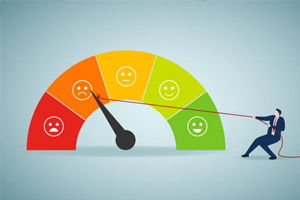How to qualify for a personal loan with bad credit?
Unlock possibilities with our guide on securing personal loans with bad credit Discover strategies, lenders, and FAQs for financial empowerment
Welcome to our comprehensive guide on qualifying for a personal loan with bad credit. Navigating the world of lending can be challenging, especially when faced with a less-than-ideal credit score. In this guide, we aim to provide valuable insights, strategies, and considerations for individuals seeking personal loans with bad credit. Whether you are looking to consolidate debt, cover unexpected expenses, or fund a significant purchase, understanding the nuances of obtaining a personal loan with bad credit is crucial.
We'll explore various aspects, including the impact of credit scores, types of personal loans available, factors influencing approval, and steps to improve your chances of qualifying. Additionally, we'll delve into alternative lending options, such as secured loans, online lenders, and peer-to-peer lending platforms, offering a comprehensive overview to empower you in making informed decisions tailored to your unique financial situation.
As we unravel the intricacies of personal loans for individuals with bad credit, we'll also address common concerns through a dedicated Frequently Asked Questions (FAQs) section. This guide is designed to be a practical resource, offering actionable advice and considerations to help you navigate the borrowing landscape successfully.
Remember, while bad credit may present challenges, it does not eliminate your opportunities for securing a personal loan. By arming yourself with knowledge and carefully considering the options presented in this guide, you can make strategic choices that align with your financial goals. Let's embark on this journey together, demystifying the process and empowering you to qualify for a personal loan even with a less-than-perfect credit history.

Understanding Credit Scores and Their Impact on Personal Loan Eligibility
Factors Influencing Credit Scores
Credit scores play a crucial role in determining personal loan eligibility, especially for individuals with bad credit. A comprehensive breakdown of the factors influencing credit scores provides insights into the key elements lenders consider when evaluating loan applicants.
1. Payment History
The most significant factor impacting credit scores is the payment history. Timely payments on credit accounts, including credit cards, loans, and mortgages, contribute positively to the credit score. On the contrary, late payments, defaults, and bankruptcies have adverse effects.
2. Credit Utilization Ratio
The credit utilization ratio, representing the percentage of available credit that a borrower uses, is another crucial factor. Maintaining a low credit utilization ratio demonstrates responsible credit management and positively influences credit scores.
3. Length of Credit History
The length of one's credit history is a consideration for lenders. A longer credit history provides more data for assessing creditworthiness. Individuals with a limited credit history, especially those with bad credit, may face challenges in this aspect.
4. Types of Credit in Use
Diversification of credit types, including credit cards, installment loans, and retail accounts, is viewed favorably. Having a mix of credit types demonstrates a well-rounded credit profile. However, individuals with bad credit may have limited options in this regard.
5. New Credit Inquiries
The number of recent credit inquiries can impact credit scores. Multiple inquiries within a short period may be interpreted as a potential risk. For individuals with bad credit, minimizing unnecessary credit inquiries is advisable to avoid negative consequences.
6. Negative Information and Public Records
Negative information such as foreclosures, tax liens, and bankruptcies significantly impacts credit scores. Lenders closely scrutinize such records when evaluating loan applications. Individuals with bad credit should be aware of the lingering effects of negative information on their credit profiles.
In summary, a comprehensive understanding of the factors influencing credit scores involves analyzing payment history, credit utilization ratio, length of credit history, types of credit in use, new credit inquiries, and the presence of negative information or public records. For those seeking personal loans with bad credit, addressing and managing these factors is crucial in improving creditworthiness and increasing the likelihood of loan approval.
Minimum Credit Score Requirements for Personal Loans
Understanding the minimum credit score requirements for personal loans is vital for individuals with bad credit seeking financing. A comprehensive breakdown of these requirements sheds light on the thresholds set by lenders and the implications for loan eligibility.
1. Excellent Credit (720 and Above)
Individuals with excellent credit scores, typically 720 and above, have access to the most favorable personal loan terms. Lenders offer lower interest rates, higher loan amounts, and more flexible repayment terms to borrowers in this credit category.
2. Good Credit (680 to 719)
Good credit scores, ranging from 680 to 719, still position borrowers well for personal loan approval. While interest rates may be slightly higher than those for excellent credit, individuals in this range generally qualify for competitive loan terms.
3. Fair Credit (620 to 679)
Fair credit scores, falling between 620 and 679, represent a mid-range credit category. While individuals in this bracket may qualify for personal loans, they might encounter higher interest rates and more stringent eligibility criteria.
4. Poor Credit (580 to 619)
For individuals with poor credit scores ranging from 580 to 619, obtaining a personal loan becomes more challenging. Lenders may impose stricter terms, higher interest rates, and lower loan amounts. Exploring alternative lenders specializing in bad credit loans becomes crucial in this range.
5. Very Poor Credit (579 and Below)
Individuals with very poor credit, a score of 579 and below, face the most significant challenges in securing traditional personal loans. In this category, alternative lending options such as online lenders, peer-to-peer platforms, and secured loans may be more accessible.
6. No Minimum Requirement (Subprime Lenders)
Some lenders, known as subprime lenders, cater specifically to individuals with bad or no credit. These lenders may not have strict minimum credit score requirements, making them a viable option for those with challenging credit histories. However, caution is advised as interest rates can be substantially higher.
In conclusion, the minimum credit score requirements for personal loans vary across credit categories. Understanding where one falls on the credit score spectrum is essential for managing expectations and exploring lenders that align with individual credit profiles. For those with bad credit, exploring alternative lenders and improving credit scores over time can open up more favorable personal loan options.
Strategies to Improve Credit Score
Timely Payment of Existing Debts
Ensuring the timely payment of existing debts is a crucial strategy for individuals looking to qualify for a personal loan, especially when dealing with bad credit. A comprehensive breakdown of this strategy explores various aspects of debt management and its impact on creditworthiness.
1. Prioritize On-Time Payments
The foundation of a positive credit history lies in prioritizing on-time payments for all existing debts. This includes credit cards, loans, and other financial obligations. Consistent and punctual payments contribute significantly to a favorable credit report.
2. Understand the Importance of Payment History
Lenders place a high emphasis on payment history when evaluating loan applications. A clean payment history, free from late payments or defaults, demonstrates financial responsibility and builds trust with potential lenders. Understanding the weight of payment history is essential for borrowers seeking to improve their creditworthiness.
3. Set Up Automatic Payments
To avoid the risk of missing payment deadlines, individuals can consider setting up automatic payments for their existing debts. This automated approach ensures that payments are made on time each month, reducing the likelihood of late fees and negative entries on credit reports.
4. Negotiate with Creditors for Flexibility
If facing challenges in meeting payment deadlines, proactive communication with creditors is crucial. Negotiating for more flexible payment terms or discussing temporary financial hardships can help borrowers avoid negative entries on their credit reports. Many creditors are willing to work with individuals facing difficulties, providing a temporary reprieve.
5. Utilize Financial Tools and Apps
Various financial tools and apps are available to help individuals manage and track their debt payments. These tools often provide reminders, budgeting assistance, and insights into spending patterns. Leveraging such resources can contribute to better financial management and, consequently, improved creditworthiness.
6. Consider Debt Consolidation
For individuals juggling multiple debts, debt consolidation may be a viable option. Combining multiple debts into a single, manageable loan can simplify payments and reduce the risk of missed deadlines. However, it's essential to carefully evaluate the terms and potential impact on credit scores before opting for consolidation.
7. Regularly Monitor Credit Reports
Regularly monitoring credit reports allows individuals to stay informed about their credit status. Identifying and addressing any inaccuracies or discrepancies promptly is essential for maintaining a clean credit history. This proactive approach ensures that credit reports accurately reflect an individual's financial responsibility.
In summary, ensuring the timely payment of existing debts involves prioritizing on-time payments, understanding the importance of payment history, setting up automatic payments, negotiating with creditors, utilizing financial tools, considering debt consolidation, and regularly monitoring credit reports. This comprehensive approach contributes to a positive credit history and enhances eligibility for personal loans, even for individuals with bad credit.
Credit Utilization Ratio Management
Effectively managing the credit utilization ratio is a critical aspect of improving creditworthiness for individuals seeking to qualify for a personal loan, particularly when dealing with bad credit. A comprehensive breakdown of this strategy explores the intricacies of credit utilization and its impact on overall credit health.
1. Understanding Credit Utilization Ratio
The credit utilization ratio is the percentage of available credit that an individual is currently using. It is a key factor in credit scoring algorithms and plays a significant role in determining creditworthiness. Understanding how this ratio is calculated is fundamental to managing it effectively.
2. Aim for Low Utilization Rates
Lenders generally view lower credit utilization ratios more favorably. Aim to keep the utilization rate as low as possible by using only a small portion of the available credit. This reflects positively on credit reports and signals responsible credit management.
3. Regularly Monitor Credit Card Balances
Regularly monitoring credit card balances is essential for managing the credit utilization ratio. Keeping track of balances allows individuals to stay within a target utilization range. Sudden increases in balances can negatively impact the ratio and, subsequently, credit scores.
4. Paying Down Balances Strategically
Strategically paying down credit card balances can be an effective approach to manage the credit utilization ratio. Focus on paying off high-interest or high-balance cards first to achieve a more balanced utilization across all credit accounts.
5. Avoid Closing Unused Credit Cards
Closing unused credit cards may seem like a way to simplify finances, but it can adversely affect the credit utilization ratio. The total available credit decreases when a card is closed, potentially leading to a higher utilization percentage. Consider keeping unused cards open to maintain a more favorable ratio.
6. Request Credit Limit Increases
Requesting credit limit increases from credit card issuers can positively impact the credit utilization ratio. However, this strategy requires responsible use of the increased credit to avoid the temptation of higher spending. Be cautious not to accumulate additional debt after receiving a credit limit increase.
7. Diversify Credit Types
Diversifying the types of credit used can contribute to a healthier credit utilization ratio. Including installment loans or lines of credit in addition to credit cards adds variety to the credit profile. This diversity can positively impact overall credit health.
8. Seek Professional Financial Counseling
For individuals struggling with high credit card balances and a challenging credit utilization ratio, seeking professional financial counseling may be beneficial. Credit counselors can provide personalized guidance on debt management, budgeting, and improving overall credit health.
In summary, effective credit utilization ratio management involves understanding the ratio, aiming for low utilization rates, regularly monitoring credit card balances, strategically paying down balances, avoiding the closure of unused credit cards, requesting credit limit increases responsibly, diversifying credit types, and seeking professional financial counseling when needed. Incorporating these strategies into one's financial routine can contribute to a more favorable credit profile and increase eligibility for personal loans, even with a history of bad credit.
Addressing Errors on Credit Reports
Addressing errors on credit reports is a crucial step in improving creditworthiness, particularly for individuals with bad credit seeking to qualify for a personal loan. A comprehensive breakdown of this strategy explores the importance of accurate credit reports and the steps to rectify errors.
1. Regularly Check Credit Reports
Regularly checking credit reports is the first line of defense against inaccuracies. Obtain free annual credit reports from major credit bureaus and review them thoroughly. Look for any discrepancies, inaccuracies, or fraudulent activities that may impact credit scores.
2. Scrutinize Personal Information
Start by scrutinizing personal information on the credit report, including name, address, and social security number. Even minor errors in personal details can lead to confusion and potentially impact credit scores. Ensure that all information is accurate and up-to-date.
3. Review Account Information
Review each listed account for accuracy. Check balances, payment history, and account statuses. Any discrepancies, such as incorrect payment statuses or unauthorized accounts, should be reported promptly to the respective credit bureau.
4. Dispute Inaccuracies Online
Most credit bureaus provide online dispute resolution platforms. If errors are identified, utilize these online tools to initiate disputes. Clearly outline the inaccuracies, provide supporting documentation, and submit the dispute. Online disputes often expedite the resolution process.
5. Send Certified Letters for Formal Disputes
For more complex disputes or cases where online tools are insufficient, consider sending certified letters to the credit bureaus. Clearly articulate the errors, enclose relevant documentation, and request a thorough investigation. Certified letters provide a paper trail and proof of communication.
6. Follow Up on Disputes
After initiating disputes, follow up with the credit bureaus to ensure timely resolution. Credit bureaus are required to investigate and respond within a specified period. Persistent follow-up ensures that corrections are made promptly, preventing lingering negative effects on credit scores.
7. Monitor Credit Reports After Disputes
Once disputes are resolved, continue monitoring credit reports to confirm that corrections have been made. Occasionally errors may persist, and ongoing monitoring allows for prompt action if further disputes are necessary.
8. Report Fraud or Identity Theft
If errors are a result of fraud or identity theft, report the incident to the credit bureaus and law enforcement immediately. Place fraud alerts on credit reports to prevent further unauthorized activities and take necessary steps to restore the integrity of the credit profile.
In summary, addressing errors on credit reports involves regularly checking reports, scrutinizing personal and account information, disputing inaccuracies online or through certified letters, following up on disputes, monitoring reports after resolution, and reporting fraud or identity theft promptly. Proactive management of credit reports ensures accuracy and contributes to an improved credit profile for individuals seeking personal loans with a history of bad credit.
Exploring Lenders Specializing in Bad Credit Personal Loans
Online Lenders
Online lenders have emerged as a viable option for individuals with bad credit seeking personal loans. A comprehensive breakdown of online lenders explores the advantages, considerations, and key factors to assess when choosing this borrowing avenue.
1. Accessibility and Convenience
Online lenders offer unparalleled accessibility and convenience. The digital application process allows borrowers to apply from the comfort of their homes, saving time and eliminating the need for in-person visits. This accessibility is particularly beneficial for individuals with bad credit seeking efficient and hassle-free loan solutions.
2. Diverse Lending Options
Online lenders provide a diverse range of lending options catering to various credit profiles. While interest rates may be higher for individuals with bad credit, the availability of tailored loan products increases the likelihood of finding a suitable option. Borrowers can explore different terms, repayment plans, and loan amounts to align with their financial needs.
3. Speedy Approval and Disbursement
One of the standout features of online lenders is their ability to provide speedy approval and disbursement of funds. For individuals in need of quick financial solutions, online lenders can offer rapid responses to loan applications and swift access to funds upon approval.
Peer-to-Peer Lending Platforms
Peer-to-peer (P2P) lending platforms represent a unique approach to personal lending, connecting borrowers directly with individual investors. A comprehensive breakdown of P2P lending explores the collaborative nature, benefits, and considerations associated with this borrowing model.
1. Competitive Interest Rates
Competition among individual lenders on P2P platforms can lead to competitive interest rates. Borrowers with bad credit may find more favorable terms compared to traditional lenders. The decentralized nature of P2P lending allows for negotiation and customization of interest rates based on individual borrower profiles.
2. Flexible Terms and Repayment Plans
P2P lending platforms often offer more flexibility in terms and repayment plans compared to conventional lenders. Borrowers can negotiate terms directly with lenders, creating a personalized agreement that aligns with their financial capabilities. This flexibility is advantageous for individuals with bad credit seeking tailored solutions.
3. Streamlined Application Process
The application process on P2P lending platforms is typically streamlined and user-friendly. Borrowers can create profiles, submit loan requests, and provide necessary documentation online. The digital nature of P2P lending enhances convenience and expedites the borrowing process for individuals with bad credit.
Secured Personal Loans
Secured personal loans involve providing collateral to secure the loan, offering a potential avenue for individuals with bad credit to access financing. A comprehensive breakdown of secured personal loans explores the benefits, risks, and considerations associated with this type of borrowing.
1. Lower Interest Rates
Secured personal loans often come with lower interest rates compared to unsecured options. The presence of collateral mitigates the lender's risk, resulting in more favorable terms for borrowers with bad credit. Lower interest rates contribute to a more manageable cost of borrowing.
2. Higher Loan Amounts
Collateral allows borrowers to access higher loan amounts than they might qualify for with unsecured loans. This can be beneficial for individuals with substantial collateral, such as home equity, who need larger sums for specific purposes like debt consolidation or major expenses.
3. Risk of Asset Seizure
The primary risk of secured personal loans is the potential seizure of the pledged asset in case of loan default. Borrowers must carefully consider their ability to meet repayment obligations to avoid the loss of valuable assets. This risk is a crucial factor for individuals contemplating secured loans.
4. Types of Acceptable Collateral
Secured loans accept various types of collateral, including real estate, vehicles, or other valuable assets. Understanding the types of acceptable collateral is essential for borrowers with bad credit exploring this option. The choice of collateral depends on individual circumstances and the assets available for pledging.
In summary, online lenders offer accessibility, diverse lending options, and speedy processing for individuals with bad credit. Peer-to-peer lending platforms provide competitive interest rates, flexible terms, and a streamlined application process. Secured personal loans offer lower interest rates, higher loan amounts, but come with the risk of asset seizure. Understanding the nuances of each option empowers individuals with bad credit to make informed decisions based on their unique financial situations and borrowing needs.
Collateral Options for Secured Personal Loans
Real Estate Equity
Using real estate equity as collateral for secured personal loans is a strategic option for individuals with bad credit. A comprehensive breakdown of leveraging real estate equity explores the benefits, considerations, and potential risks associated with this type of secured borrowing.
1. Home Equity Loans and HELOCs
Real estate equity can be tapped through home equity loans or home equity lines of credit (HELOCs). Home equity loans provide a lump sum amount, while HELOCs offer a revolving line of credit. Understanding the differences between these options is essential for borrowers seeking to leverage their real estate equity.
2. Higher Loan Amounts
Real estate equity allows borrowers to access higher loan amounts compared to unsecured loans. The value of the equity in the property serves as a basis for determining the loan amount. This can be advantageous for individuals with bad credit who need substantial funds for major expenses or debt consolidation.
3. Potentially Lower Interest Rates
Securing a loan with real estate equity often results in lower interest rates compared to unsecured options. Lenders view collateral-backed loans as less risky, leading to more favorable terms. Lower interest rates contribute to a more cost-effective borrowing solution for individuals with bad credit.
4. Risk of Property Seizure
The primary risk associated with using real estate equity is the potential seizure of the property in case of default. Borrowers must carefully assess their ability to meet repayment obligations to avoid the loss of their home or property. This risk underscores the importance of responsible borrowing and thorough financial planning.
5. Appraisal and Loan-to-Value Ratio
Before securing a loan with real estate equity, an appraisal of the property is typically required. Lenders use the appraised value and calculate the loan-to-value (LTV) ratio to determine the maximum loan amount. Understanding these factors helps borrowers assess the feasibility and potential loan amount based on their property's value.
Automobiles and Other Assets
Securing personal loans with automobiles and other valuable assets is an alternative for individuals with bad credit. A comprehensive breakdown of this secured borrowing option explores the nuances, advantages, and considerations associated with using assets other than real estate as collateral.
1. Types of Acceptable Assets
Various assets, including automobiles, jewelry, electronics, or valuable collectibles, can serve as collateral for secured personal loans. Understanding the types of assets acceptable to lenders is crucial for borrowers exploring this option.
2. Quick Access to Funds
Securing loans with assets other than real estate can provide quick access to funds. The evaluation process for these assets is often more straightforward, allowing for expedited loan approval and disbursement. This feature is beneficial for individuals with urgent financial needs.
3. Potential Risk of Asset Seizure
Similar to real estate equity, the primary risk is the potential seizure of the pledged asset in the event of default. Borrowers must carefully evaluate their financial situation and repayment capabilities to avoid the loss of valuable assets. This risk emphasizes the importance of responsible borrowing and thorough assessment.
4. Valuation and Condition of Assets
Before using assets as collateral, lenders typically assess their valuation and condition. The value of the asset and its depreciation over time influence the loan amount and terms. Borrowers should be aware of the factors that may affect the appraisal and subsequent loan offer.
5. Diverse Range of Acceptable Assets
Securing personal loans with assets other than real estate provides a diverse range of acceptable collateral. This flexibility allows borrowers to leverage various valuable items, expanding the possibilities for obtaining secured loans. It is essential to explore lenders willing to accept the specific assets offered as collateral.
In summary, leveraging real estate equity involves considerations such as home equity loans, higher loan amounts, potentially lower interest rates, the risk of property seizure, and appraisal processes. Using automobiles and other assets as collateral includes types of acceptable assets, quick access to funds, potential risk of asset seizure, and the valuation and condition of assets. Understanding these aspects empowers individuals with bad credit to make informed decisions when choosing between different types of collateral for secured personal loans.
Alternative Options for Individuals with Extremely Low Credit Scores
Co-Signers and Joint Applicants
Exploring the option of having co-signers or joint applicants can be a strategic approach for individuals with bad credit seeking personal loans. A comprehensive breakdown of this collaborative borrowing model examines the advantages, considerations, and potential implications for both borrowers and co-signers.
1. Enhanced Loan Approval Odds
Having a co-signer or joint applicant with a stronger credit profile can significantly enhance the likelihood of loan approval. Lenders may be more willing to extend credit when the application involves a co-signer or joint applicant with a better credit history. This collaborative approach provides an opportunity for individuals with bad credit to secure financing.
2. Improved Loan Terms and Interest Rates
Co-signers or joint applicants with better credit can contribute to improved loan terms and lower interest rates. Lenders may offer more favorable conditions when there is a lower perceived risk associated with the application. This can result in reduced borrowing costs and more manageable repayment terms for individuals with bad credit.
3. Shared Financial Responsibility
Co-signers and joint applicants share financial responsibility for the loan. This collaborative arrangement requires open communication and a mutual understanding of the obligations involved. Both parties should be aware of the potential impact on their credit profiles and the importance of meeting repayment obligations to maintain a positive financial relationship.
4. Potential Strain on Relationships
While co-signing or applying jointly can strengthen financial prospects, it may also introduce potential strains on relationships. Clear communication and transparency are essential to address expectations, responsibilities, and potential challenges. Both parties should have a thorough understanding of the commitment involved to mitigate potential conflicts.
5. Credit Impact for Co-Signers
Co-signers should be aware that the loan will appear on their credit reports. Any missed payments or defaults by the primary borrower can negatively impact the co-signer's credit score. It is crucial for co-signers to assess the level of risk they are comfortable assuming and to discuss contingency plans in case of unforeseen challenges.
Payday Loans and Short-Term Solutions
For individuals with bad credit facing urgent financial needs, payday loans and short-term solutions represent alternative borrowing avenues. A comprehensive breakdown of these options explores the characteristics, benefits, and potential drawbacks associated with payday loans and short-term lending.
1. Quick Access to Funds
One of the primary advantages of payday loans is the quick access to funds. These loans are designed for short-term financial needs and often provide rapid approval and disbursement processes. Individuals with bad credit requiring immediate cash for emergencies may find payday loans to be a convenient solution.
2. Limited Credit Checks
Payday lenders typically conduct minimal credit checks, making these loans accessible to individuals with bad credit. The focus is often on the borrower's income and ability to repay the loan within a short period. This lenient approach to credit assessment makes payday loans a potential option for those with challenging credit histories.
3. High Interest Rates and Fees
One of the main drawbacks of payday loans is the high interest rates and fees associated with this form of lending. The short-term nature of these loans often results in elevated annual percentage rates (APRs). Borrowers should carefully consider the total cost of borrowing and evaluate alternatives before opting for payday loans.
4. Potential Debt Cycle
Payday loans can lead to a potential debt cycle, especially if borrowers struggle to repay the loan within the designated timeframe. The high fees and interest rates may result in financial challenges, leading to a reliance on additional payday loans. Borrowers should exercise caution and ensure they have a realistic plan for timely repayment.
5. Regulatory Considerations
Regulations governing payday loans vary by jurisdiction. Borrowers should be aware of the legal and regulatory framework in their location, including maximum loan amounts, interest rate caps, and repayment terms. Understanding the regulatory landscape helps borrowers make informed decisions and avoid potential pitfalls associated with non-compliance.
In summary, exploring co-signers or joint applicants involves assessing the collaborative advantages, considering potential strains on relationships, and understanding credit impacts. Payday loans and short-term solutions offer quick access to funds with limited credit checks but come with high interest rates and fees, potential debt cycles, and regulatory considerations. Individuals with bad credit should carefully evaluate these options based on their specific financial needs and circumstances.
Choosing the Right Personal Loan for Your Situation
1. Self-Assessment of Financial Needs
Begin by conducting a comprehensive self-assessment of your financial needs. Clearly outline the purpose of the loan, whether it's for debt consolidation, home improvement, emergency expenses, or other specific reasons. Understanding your financial objectives helps in determining the appropriate loan amount and terms.
2. Credit Score and Credit History
Assess your credit score and credit history to determine the impact on loan eligibility and interest rates. Individuals with higher credit scores may qualify for unsecured loans with better terms, while those with bad credit might explore secured or alternative lending options. Understanding your credit profile guides you toward lenders more likely to approve your application.
3. Consideration of Loan Types
Explore different types of personal loans, including unsecured loans, secured loans, peer-to-peer lending, and online lenders. Each type has its advantages and considerations. Unsecured loans don't require collateral but may have higher interest rates. Secured loans offer lower rates but involve pledging assets. Evaluate the pros and cons of each to align with your preferences and risk tolerance.
4. Interest Rates and Terms
Compare interest rates and loan terms from various lenders. While interest rates significantly impact the cost of borrowing, the terms of the loan, including repayment period and monthly installments, are equally important. Strive for a balance between competitive rates and manageable terms that align with your financial capabilities.
5. Fees and Hidden Charges
Be vigilant about fees and hidden charges associated with personal loans. Lenders may impose origination fees, prepayment penalties, or other charges that impact the overall cost of the loan. Carefully review the loan agreement to identify all potential fees, ensuring transparency and preventing unexpected financial burdens.
6. Repayment Flexibility
Consider the repayment flexibility offered by different lenders. Some lenders provide flexible repayment options, such as bi-weekly payments or customizable repayment schedules. Assess your ability to adhere to the proposed repayment structure and choose a lender that aligns with your preferred repayment frequency and flexibility.
7. Co-Signing or Joint Applications
If your credit is a limiting factor, explore the possibility of having a co-signer or a joint applicant. This collaborative approach can enhance approval odds and improve loan terms. However, it requires open communication, as both parties share financial responsibility, and any missed payments can affect the co-signer's credit.
8. Regulatory Compliance
Ensure that the chosen lender complies with relevant regulations and legal requirements. Understanding the regulatory landscape helps protect your rights as a borrower and ensures fair and ethical lending practices. Research the lender's reputation, reviews, and compliance with industry standards before committing to a personal loan.
9. Financial Counseling and Guidance
If uncertain about the best loan option or struggling to navigate the borrowing landscape, consider seeking financial counseling. Professional guidance can provide valuable insights, helping you make informed decisions about the type of loan, terms, and overall financial strategy. Many non-profit organizations offer free financial counseling services.
10. Reviews and Testimonials
Read reviews and testimonials from other borrowers who have used the services of the lenders you are considering. Real-world experiences can offer valuable insights into the lender's customer service, transparency, and overall satisfaction of borrowers. Pay attention to both positive and negative feedback to make a well-rounded assessment.
In conclusion, choosing the right personal loan requires a thorough self-assessment, consideration of credit scores, exploration of loan types, careful evaluation of interest rates and terms, awareness of fees, assessment of repayment flexibility, consideration of collaborative approaches, compliance with regulations, access to financial counseling, and review of lender reviews and testimonials. By systematically considering these factors, you can make an informed decision that aligns with your financial goals and circumstances.
FAQs about Qualifying for a Personal Loan with Bad Credit
Q1: Can I qualify for a personal loan with bad credit?
A1: Yes, it is possible to qualify for a personal loan with bad credit. Many lenders specialize in providing loans to individuals with less-than-perfect credit. However, the terms and interest rates may vary based on your credit profile. Exploring alternative lenders, such as online lenders or those offering secured loans, can increase your chances of approval.
Q2: How does my credit score impact my ability to get a personal loan?
A2: Your credit score is a significant factor in determining your eligibility for a personal loan. A lower credit score may result in higher interest rates and less favorable terms. It's essential to check your credit score before applying and consider lenders who specialize in bad credit loans. Additionally, having a co-signer with a higher credit score can enhance your approval odds and improve loan terms.
Q3: What types of personal loans are available for individuals with bad credit?
A3: Individuals with bad credit can explore various types of personal loans, including unsecured loans, secured loans, peer-to-peer lending, and online lenders. Unsecured loans do not require collateral but may have higher interest rates. Secured loans involve pledging assets, potentially leading to better terms. Peer-to-peer lending and online lenders often consider alternative factors beyond credit scores, providing additional options for those with bad credit.
Q4: Are there specific steps I can take to improve my chances of approval?
A4: Yes, there are steps you can take to improve your chances of approval. First, review your credit report for any errors and dispute inaccuracies. Consider having a co-signer with a higher credit score, as it can positively impact your eligibility and loan terms. Exploring lenders who consider factors beyond credit scores, such as income and employment stability, can also enhance your approval odds.
Q5: What should I be cautious about when applying for a personal loan with bad credit?
A5: When applying for a personal loan with bad credit, be cautious about high interest rates and fees. Some lenders may take advantage of the higher risk associated with bad credit, resulting in substantial borrowing costs. Carefully review the terms and conditions, including any hidden fees. Additionally, ensure that the lender is reputable and compliant with relevant regulations to avoid potential pitfalls.




























